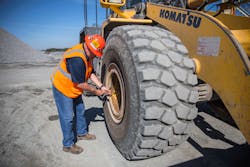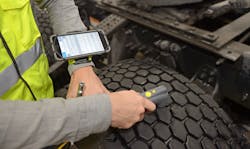Equipment managers know production equals revenue, but running machines over damaged roads can become a costly tire maintenance expense. Although rough work sites are often overlooked when it comes to wear, monitoring technology can track defects and assist in preventing future damage.
BKT Tires’ SpotTech software, for example, uses a GPS system, GoPro camera, and accelerometer to capture grade and lateral force readings. In one instance, says VP Doug Kershaw, the company used SpotTech to test a customer site and found a small dip in the road was causing more tire damage than expected.
“Drivers had to slow down to go over the dip,” he said. “With the slowdown and the speed back up afterward, they found they were spending an extra million dollars a year on fuel. All they had to do was fill in the hole.”
Asset monitoring technology can track defects and assist in preventing future damage in tires.
Shawn Rasey, director of global business development for earthmover tires at Continental Tires, says roads that attract standing water are also hazardous.
“If a truck is running through ponded water, you never know what’s going to be under that water,” Rasey says. “A lot of time it’s a big sharp rock, and when you put a rock with water and rubber, that’s always a tire killer.”
He cited one Chicago-based aggregate producer as an example. According to Rasey, when it rains, water floods loading areas and parts of the haul road.
“You may be operating one day on a nice, smooth road that’s been well maintained,” Rasey says. “Maybe there are rocks that you use your motor grader to clean up. But the next day, you get three inches of rain. All of a sudden those ponded areas start popping up, and now you’ve got a problem.
“The most effective way to deal with road issues would be proactively trying to level out those roads ahead of time,” he says. “Getting the right grade on them will help dissipate the water.”
Work sites with sharp turns also contribute to tire wear. Continential’s ContiLogger Live software picks up the speed, distance, grade, and lateral forces that tires experience when maneuvering on-site.
“If you have a hairpin corner, you could put an elevated curve in, or change the curve,” Rasey says. “That could eliminate a lot of problems that you’re having with tires. They’re not built to take that kind of punishment.”
BKT’s SpotTech also detected issues with sharp turns on a customer work site.
“We told the customer that if they changed the angle curvature and the vehicle no longer had to brake and take a turn, they would save thousands of dollars,” Kershaw says.
How technology saves construction tires
Using tire-management software to follow the life of a tire also helps managers understand total cost of ownership.
“Fleet managers can use software to document a complete history on every tire in their fleet—from original installation to scrap pile,” says Matt Miller, tire technology manager, Titan International.
Depending on the focus and needs, Rasey says managers are usually tracking operating hours (or miles), wear rates (changes in usable tread depth), in-service trends (how tires are projecting), and service results (how long the tires lasted in their application).
Goodyear’s TPMS Plus tire-management software (above) includes on-vehicle sensors that monitor tire conditions in real time. It then stores this data to provide predictive tire maintenance analytics.
According to Micah Tindor, Goodyear connected fleet product manager, one TPMS Plus user saved their company an estimated $1,000 after detecting an issue.
“As the driver got on the road, the system alerted the equipment manager that this particular vehicle was showing an air leak in one of its tires,” Tindor says.
The manager contacted the driver who, despite the pre-trip inspection, confirmed the tire pressure had dropped.
“This prompted the driver to stop at the next service center to repair the damaged tire, saving the company a significant amount.”
How to repair a tire on a large earthmoving machine
According to Euan Hovell, technical director at Michelin, tracking a tire’s remaining tread depth, for example, documents its wear usage and remaining value.
“You would also use the tread utilization rate knowledge to produce a monthly tire usage report and schedule tire changes, rotations, and get the most value out of the asset,” says Hovell. “By tracing the tread utilization rate, it is also possible to find the value of rubber used by the tire in dollars per 32nd of tread used.”
Gathering lifelong data can also help managers make informed maintenance decisions, and isolate causes and effects.
“The resulting findings tend to point to other actionable steps that can be taken,” Rasey says. “If there are consistent results of tires coming out of service from rock cuts, this may indicate that better monitoring and clean up of roads are required.
“It could also point to operator error, or in more rare instances, that the wrong tire is being used on the front position.”
As for the future of tire maintenance, manufacturers foresee continued technological growth.
“Tire costs aren’t going to go down, but we predict tire pressure long-term heading to remote health monitoring,” says Rob Siebert, executive director of OTR sales at Bridgestone Americas. “You can save your company significant money just by maintaining tire health.”
About the Author
Gianna Annunzio
Gianna was associate editor from 2018 - 2021.

